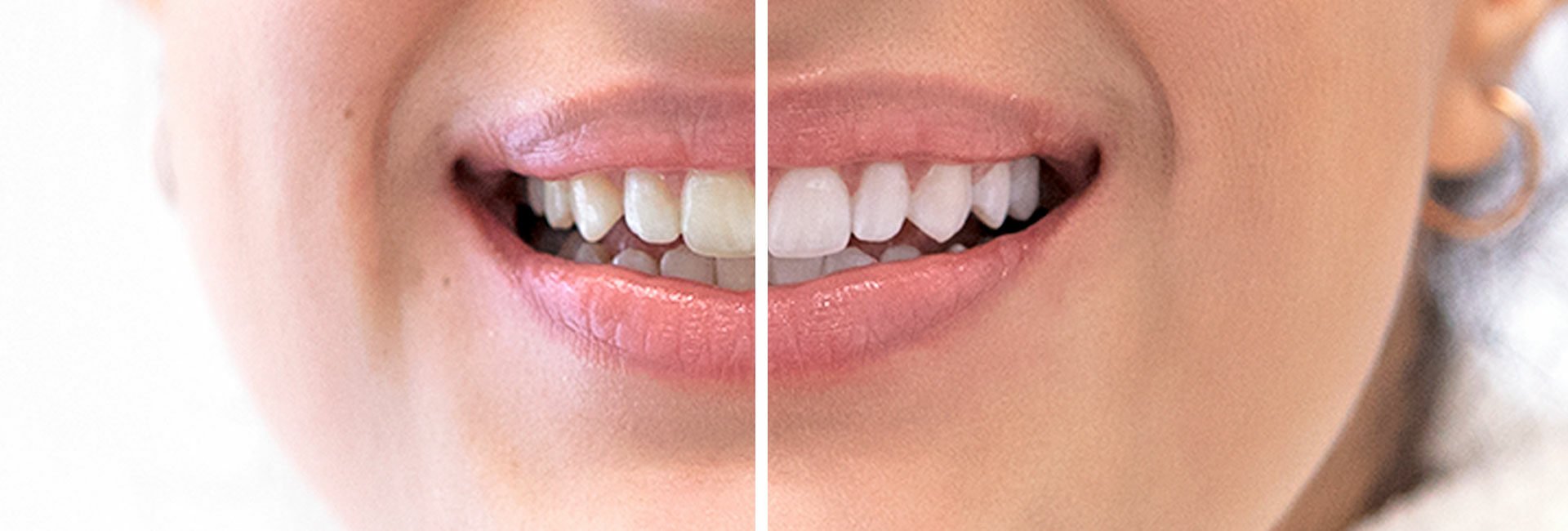
Bleaching – Tooth-friendly whitening
Being beautiful and having a healthy appearance have always been a deep desire for men and women alike. The teeth and mouth both play an important role. A radiant smile stands out straight away and sticks in your mind. The appearance of teeth has an unconscious influence on how we perceive the age, social status and the general state of health of people we meet. The colour of teeth plays a particularly important role. Many people yearn for whiter teeth, which is something that can be achieved using bleaching treatments, also carried out by a dentist.
Within the field of dentistry, tooth whitening (bleaching) normally falls under the category of an aesthetic treatment. The mouth, and the teeth that can be seen in it, tend to be the centre of attention when we meet people. The digital media have had a significant impact on society in recent years: models show off big smiles; actors shine with white teeth in Hollywood films.
This is why in-office bleaching techniques, carried out by dentists, have become extremely popular in recent years. Dark teeth, teeth with differing colours, and permanent blemishes of the teeth are all common patient complaints.
Many patients try home-bleaching products with whitening strips, trays and other products. They often forget that fillings and white areas that form due to mineralisation can lead to unpleasant surprises after bleaching. This is because fillings do not become whiter, and mineralisation spots become much whiter.
To this effect, the German Society for Dental and Oral Medicine (DGZMK) has commented: “In order to avoid both systemic and local complications, decisions regarding the indication for teeth whitening treatments, and carrying out these treatments should remain in the hands of the dentist.”
There is indeed a treatment method that provides those patients interested with the desired result of whiter teeth: the power bleaching method, carried out with the supervision of a dentist using a bleaching gel combined with exposure to a treatment ‘booster’ light. Under supervision of a dentist, a significantly higher percentage of hydrogen peroxide may be used during treatment than the amounts contained in the bleaching gels available over the counter.
How do the tooth discolourations even happen?
Here, it is important to distinguish between discolouration due to internal and external causes. Teeth that have undergone root canal treatment are dead and take on an unwanted colouring due to the material within the root canal filling. Components from the blood, as well as proteins can also visibly discolour the dead tooth. The blood is broken down, turning into a dark iron sulphide, staining the tooth material with a grey-ish colouring.
The far more frequent cause of discolouration is from outside, external sources. These include the build-up of stains due to tobacco, coffee, red wine or tea leaves. Medications can also contribute to tooth discolouration. Through professional tooth cleaning (also referred to as dental hygienist appointments), the majority of these stains can be removed using air-powered scaling devices and polishing pastes. In cases where these treatments can’t improve the situation, in-practice tooth whitening can be a way to lighten natural teeth up again.

Frequently asked questions
How does tooth whitening work?
The first step involves application of a special protective gel to gums surrounding the teeth to be treated. The lips and tongue are covered with a plastic film. The dental hygienist then applies the bleaching gel to the tooth surfaces. The teeth should have received a professional clean a few days beforehand. The gel is then activated using a special light source. This process takes about 15 minutes. The bleaching gel is then removed by suction, fresh gel reapplied, and the process repeated, usually three times. Following this, the tooth colour is many whiteness levels brighter. It’s just that easy to achieve your goal! You can reap the benefits immediately: a beaming, bright smile with whiter teeth in under an hour.
Is it best to have a preparatory treatment before having my teeth whitened?
It is always very beneficial to have a dental examination before having teeth whitened to identify any problems in the teeth to be whitened and treat them. Otherwise, it is possible for the bleaching gel to penetrate too far into the tooth enamel, causing pain in that area. Furthermore, existing fillings, veneers and crowns should be assessed as they might interfere in the colouring achieved later on. Before bleaching, the teeth are generally cleaned to remove any plaques or deposits to ensure that the bleaching substances can reach the tooth surface.
Does the whitening process damage the tooth material or tooth enamel?
No. Numerous studies have shown that these procedures are harmless in patients with a healthy set of teeth. No damage is caused to dentine, enamel, filling surfaces, or veneers, and the interior elements of the tooth (pulp) are similarly unaffected.
Is tooth whitening painful when carried out by a dentist?
During tooth whitening (or bleaching), harmful UV light is not used. Due to an effective filter, the area treated with the light does not significantly heat up. For this reason, treatment is pain-free and there are just some instances of tooth sensitivity in the case of sensitive teeth. In rare cases, on the day of the tooth whitening procedure there may be some temporary irritation.